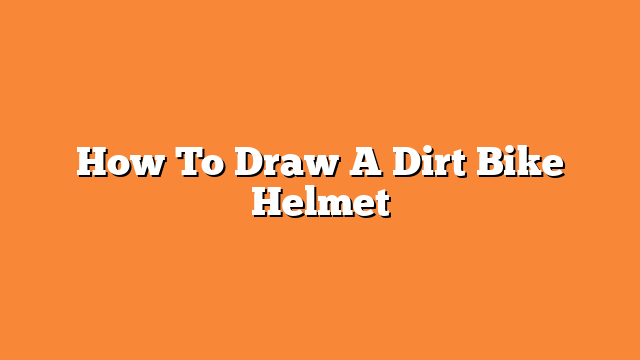Are you a fan of dirt bike racing and want to learn how to draw a dirt bike helmet?
Look no further as we guide you through the process step-by-step.
With the right materials and a little practice, you’ll be able to create a realistic and detailed drawing of a dirt bike helmet in no time.
Before you start, gather all the necessary materials such as a pencil, eraser, paper, and reference images of dirt bike helmets.
These images will help you understand the intricate details of the helmet and how light reflects off its surface.
With these materials at hand, you’re ready to start creating your masterpiece.
Follow our guide to learn how to draw a dirt bike helmet with ease and precision.
Table of Contents
- 1 Gather Materials and Reference Images
- 2 Create a Basic Sketch
- 3 Add Shading and Texture
- 4 Add Color (Optional)
- 5 Final Touches
- 6 Frequently Asked Questions
- 6.1 What are the different types of dirt bike helmets available in the market?
- 6.2 How to ensure the helmet design complies with safety regulations?
- 6.3 Can I use regular pencils or do I need special art supplies for drawing a helmet?
- 6.4 How long does it generally take to draw a dirt bike helmet?
- 6.5 What are some common mistakes beginners make when drawing a helmet?
- 7 Conclusion
Gather Materials and Reference Images
As you commence the process of drawing a dirt bike helmet, you’ll want to ensure that you gather all the necessary materials and reference images to give your artwork a professional touch.
Choosing appropriate reference images is crucial because it helps you understand the shape, structure, and details of a dirt bike helmet.
Look for images that provide different angles and perspectives of the helmet to ensure that you capture every detail accurately.
You can find reference images in online galleries, magazines, or even by taking pictures of a real helmet.
In addition to reference images, selecting suitable materials for the task is equally important.
You will need a pencil, eraser, paper, and a ruler to start sketching.
For the final drawing, you can use markers or colored pencils to add color and depth to your artwork.
It is best to use high-quality materials to ensure that your drawing looks professional and visually appealing.
Cheap materials can hinder the quality of your work and make it difficult to achieve the desired result.
To ensure that you have everything you need, create a checklist of the necessary materials and reference images before you start drawing.
This will help you stay organized and prevent any interruptions during the creative process.
Once you have all the materials and reference images, you can begin sketching the dirt bike helmet and bringing it to life with your artistic skills.
With the right materials and reference images, your artwork is sure to stand out and impress.
Create a Basic Sketch
To create a basic sketch of your dirt bike helmet, start with basic shapes such as circles and ovals to establish the overall shape and size.
Add details and proportions by sketching in the visor, vents, and any other design elements unique to your helmet.
Refine the sketch by adjusting the proportions and adding any final details until you are satisfied with the overall look.
Remember to keep your lines light and use an eraser to make any necessary adjustments.
Start with Basic Shapes
Get ready to create your dirt bike helmet masterpiece by first sketching out some basic shapes.
This step is crucial in creating a realistic and accurate drawing of a dirt bike helmet.
You can use shapes like circles, ovals, and rectangles to create the basic outline of the helmet.
By using these shapes, you can ensure that your drawing is proportionate and symmetrical.
Using shapes to draw other objects is a common technique in drawing.
It helps in breaking down complex objects into simpler forms that are easier to draw.
However, it is important to note that this technique requires practice and patience.
The more you practice, the better you will become at it.
So don’t be discouraged if your first few attempts don’t turn out the way you want them to.
Keep practicing and you will see improvement in your drawing techniques.
Add Details and Proportions
Now you can really make your artwork pop by adding intricate details and ensuring proper proportions, giving your masterpiece a sense of realism that will leave you feeling accomplished and proud.
When it comes to dirt bike helmets, there are a few proportion tips to keep in mind.
The helmet should be slightly larger than the head it’s supposed to protect, and the chin strap should sit snugly against the chin.
The visor should be proportional to the helmet and should not be too long or too short.
To add details to your dirt bike helmet drawing, start by sketching in the vents and air intakes.
Dirt bike helmets are designed to keep the rider cool as well as safe, so these details are important.
You can also add logos and decals to the helmet, which will give it a unique look and add to the realism of your drawing.
Use shading and highlights to give the helmet a sense of depth and dimension, and pay attention to the way light would hit the different parts of the helmet.
With these detailing techniques, your dirt bike helmet drawing will be sure to impress.
Refine the Sketch
As you refine the sketch, the helmet begins to take on a life of its own, becoming a powerful symbol of speed and adventure that ignites a sense of excitement within the viewer.
Refining techniques are crucial in ensuring that your drawing is as realistic and accurate as possible.
One common mistake that many beginners make is not paying enough attention to the details of the helmet, resulting in a drawing that lacks depth and dimension.
To refine your sketch, start by adding shadows and highlights to the helmet.
This will help to create the illusion of depth and make the helmet look more three-dimensional.
You can use a variety of shading techniques, such as hatching and cross-hatching, to achieve this effect.
Another important aspect of refining the sketch is paying attention to the proportions of the helmet.
Make sure that the various parts of the helmet, such as the visor and the chin strap, are in the correct positions and are the right size in relation to one another.
By taking the time to refine your sketch, you can create a dirt bike helmet drawing that is truly impressive and captures the spirit of adventure that is so integral to this exciting sport.
Add Shading and Texture
Now that you have your basic sketch of a dirt bike helmet, it’s time to add shading and texture to make it look more realistic.
The first step is to determine the light source, which will help you to add shadows and highlights.
Next, you can create texture using techniques like stippling and cross-hatching to give the helmet a more three-dimensional appearance.
With these techniques, you can make your helmet drawing really pop off the page.
Determine Light Source
To really make the dirt bike helmet pop, figure out where the light source is coming from.
This will help you determine where the shadows and highlights should be placed.
Think about whether the light source is coming from above, below, or to the side of the helmet.
Once you have determined the light source, adjust the angles of your shading accordingly.
Choosing the right materials for shading can also make a big difference in the final result.
Charcoal pencils or graphite pencils are great for creating shadows and texture, while white pencils or pastels can be used to add highlights.
Experiment with different materials to see what works best for you and the specific look you are going for.
Remember to take your time and work slowly, building up the shading gradually until you achieve the desired effect.
With a little practice, you can create a realistic and eye-catching dirt bike helmet drawing.
Add Shadows and Highlights
Create depth and dimension in your artwork by incorporating shadows and highlights that reflect the direction of the light source.
Using gradients in shading can help you achieve a smoother and more natural-looking transition between shadow and light areas.
Start by identifying the areas where the light hits the helmet and mark them with a light pencil stroke.
Then, shade the areas that are facing away from the light source with a darker pencil, gradually building up the intensity of the shadow.
Use a blending tool or your finger to blend the edges of the shadow, creating a smoother transition.
Emphasizing shadows can help you create a more dramatic effect and add depth to your drawing.
Pay attention to the areas where the shadows fall and use a darker pencil to create a more intense shadow.
You can also use a white pencil or eraser to add highlights to the areas where the light hits the helmet.
This will help create a contrast between the light and shadow areas and make your drawing more dynamic.
Remember to adjust the intensity of the shadow and highlights based on the direction of the light source to make your drawing more realistic.
Create Texture using Stippling and Cross-Hatching
You can achieve a realistic and detailed look in your artwork by using stippling and cross-hatching techniques to create texture.
Stippling involves creating a pattern of dots to simulate texture, while cross-hatching involves creating a pattern of lines.
These techniques can be used to create the illusion of texture on different surfaces, such as metal, plastic, or fabric.
To effectively use stippling and cross-hatching, it is important to understand the differences between the two techniques.
Stippling is best used for creating subtle and soft texture, while cross-hatching is better suited for creating bold and defined texture.
Moreover, it is important to vary the size, spacing, and direction of the dots or lines to create a more natural and organic texture.
By mastering these texturing techniques, you can add depth and dimension to your dirt bike helmet drawing, making it look more realistic and engaging.
Add Color (Optional)
Now, it’s time to add some color to your dirt bike helmet masterpiece.
Imagine splashing vibrant shades of red, blue, and yellow onto the helmet’s surface, bringing it to life like a fiery comet streaking through the air.
Adding color to your helmet can enhance its overall appearance and make it stand out in a crowd.
Before you begin, consider different color schemes that would complement your helmet design.
When it comes to adding color to your dirt bike helmet, there are several options available.
You can use markers, paint, or even airbrushing techniques to achieve the desired effect.
Consider using a fine-tipped paintbrush or airbrush to create intricate designs and patterns on your helmet.
Remember to use light strokes and build up the color gradually to prevent smudging or running.
If you’re feeling adventurous, try experimenting with different color combinations and shades to create a unique helmet design.
You can use contrasting colors to create a bold and eye-catching design, or use complementary colors to create a more harmonious look.
Whatever color scheme you choose, remember to have fun and let your imagination run wild as you add the finishing touches to your dirt bike helmet masterpiece.
Final Touches
Now that you have added color to your dirt bike helmet drawing, it’s time to focus on the final touches.
First, clean up any messy lines or mistakes with an eraser or whiteout pen.
Next, add any final details and highlights to make your drawing pop.
Finally, step back and admire your work!
You’ve put in the time and effort to create a great drawing, so take a moment to appreciate it.
Clean up the Drawing
Alright, it’s time to tidy up your dirt bike helmet drawing and make it look even cooler.
First, start by fixing any mistakes you may have made during the drawing process.
Look closely at your lines and shapes, and use an eraser to clean up any smudges or stray marks.
This will give your drawing a cleaner, more polished look.
If you’re using digital tools to draw your helmet, take advantage of the software’s editing features.
Use the eraser tool to remove any unwanted lines, and use the smoothing tool to make your lines appear smoother and more refined.
Don’t be afraid to zoom in and take a closer look at your drawing – this will help you catch any mistakes you may have missed before.
Once you’ve cleaned up your drawing, take a step back and admire your work.
You’ve created a fantastic dirt bike helmet drawing that looks both realistic and cool.
Keep practicing and refining your skills, and you’ll be amazed at how quickly you improve.
Add Final Details and Highlights
To take your drawing of a dirt bike helmet to the next level, you’ll want to add some final details and highlights that will make it really pop.
Here are three tips to help you add those finishing touches:
- Look into current helmet design trends: To make your drawing look realistic and up-to-date, it’s important to research current helmet design trends.
Look up popular brands and styles to get an idea of how the helmet should look.
- Choose color schemes carefully: The colors you choose can make or break your drawing.
Consider the overall look and feel you’re going for and choose colors that complement each other.
You might also want to think about the rider’s personality and the type of bike they ride when selecting colors.
- Add highlights for depth and dimension: Adding highlights to your drawing helps create the illusion of depth and dimension.
Use a lighter shade of the base color to add highlights to areas that would naturally catch the light, such as the top of the helmet or the edges of any vents or ridges.
This will make your drawing look more realistic and add a professional touch.
Step Back and Admire Your Work!
Don’t forget to take a moment to step back and admire the masterpiece you’ve created!
It’s important to reflect on your artwork and appreciate all the hard work you’ve put in.
Take some time to look at your dirt bike helmet drawing from a distance, and see how the different elements come together to create a cohesive image.
Reflection techniques can help you improve your skills and identify areas for growth in your artwork.
Take note of what worked well in your drawing, and what you could improve upon in future projects.
It’s also important to share your artwork with others, whether it’s online or in person.
Feedback from other artists and enthusiasts can help you gain new perspectives and ideas, and can also be a source of motivation to keep creating.
So don’t be afraid to share your dirt bike helmet drawing with the world!
Frequently Asked Questions
What are the different types of dirt bike helmets available in the market?
There are several types of dirt bike helmets available in the market, each with unique features.
Full-face helmets offer maximum protection, while half-helmets are more lightweight.
Dual-sport helmets provide versatility but can be bulky.
The choice ultimately depends on personal preference and riding style.
How to ensure the helmet design complies with safety regulations?
To ensure your dirt bike helmet design complies with safety regulations, it’s important to prioritize helmet certification.
Incorporate unique design elements while keeping in mind the safety standards set by organizations like DOT, SNELL, and ECE.
Can I use regular pencils or do I need special art supplies for drawing a helmet?
For helmet drawing, you can use regular pencils but special art supplies are recommended for better shading and highlighting.
Art supplies like charcoal pencils, blending stumps, and kneaded erasers can help achieve a more realistic look.
How long does it generally take to draw a dirt bike helmet?
To draw a dirt bike helmet, shading is important to create a realistic look.
Using reference images can help improve accuracy.
The time it takes varies depending on skill level and detail.
Tips for shading can improve speed and quality.
What are some common mistakes beginners make when drawing a helmet?
Beginners often struggle with proportions and shading techniques when drawing helmets.
To improve, select reference images and practice perspective.
Avoid common mistakes by taking your time and focusing on details.
Conclusion
Congratulations, you have successfully learned how to draw a dirt bike helmet!
With the right materials and reference images, you can create a basic sketch and add shading and texture to give your drawing depth and realism.
Adding color is optional, but can make your drawing pop even more.
Don’t forget to add final touches, such as highlights and shadows, to make your drawing truly stand out.
Remember, practice makes perfect.
Keep honing your skills by drawing different types of helmets and experimenting with different shading and coloring techniques.
With enough practice and dedication, you can become a master at drawing dirt bike helmets and other objects.
So grab your pencils and get to work – the possibilities are endless!







